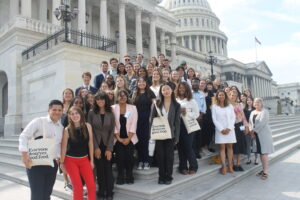APRIL 22, 2020 — Even before the Covid-19 pandemic, normal wasn’t so great for the working poor in America. Despite a 10-year recovery, 12 percent of the nation remained food insecure in 2018. The state of affairs was so economically unsustainable that food banks doubled their distribution from 2009 to 2019, to 5.25 billion pounds, serving 40 million people.

And now in 2020, with 22 million people thrown out of work in just a few weeks and an administration unable to muster much empathy for their plight, much less the cash to keep their refrigerators stocked, food banks have stepped in again to fill the void left by an absentee government. This time, however, food banks have gained more visibility, not just as the safety net under the (shredded) safety net, but as a front-line response. The miles-long lines of motorists waiting for a few sacks of groceries have become seared into the public imagination, a meme of the collective isolation and powerlessness many of us feel in the hands of an incompetent government. Charity has become the governing metaphor of the pandemic response, replacing justice, which itself has been placed on a ventilator.
But the food to feed people and the money with which to buy that food has to come from somewhere. And just as it has for the past few decades, it’s the alliance between anti-hunger organizations, the USDA, and corporate America, or the hunger industrial complex, that provides. It is this paradigm that is filling the vacuum left by Trump’s sociopathy, and as James Bailey, a management professor at George Washington University says, “Every crisis creates a void. And whatever force fills that void, inherits power.”
We should all be concerned that, in the post-pandemic era, the hunger industrial complex becomes more robust at the expense of the movement for fair wages, strong nutrition programs, and universal health care. Frankly, the unholy alliance between food banks and corporate America has shown itself to be more interested in maintaining the problem of hunger than actually solving it.
The existence of this unholy alliance poses the fundamental question of: “Why end hunger when anti-hunger work is so profitable to all parties?” Through supporting anti-hunger organizations, corporations reduce their labor costs, garbage disposal fees, and tax bills while building their reputations as socially responsible firms.
For food banks, hard times are good times. Their fundraising soars during recessions, and all too often they measure their success in the number of pounds that they distribute. The higher the poundage, the more they appear to be successful, and the more the donations come flowing in.
During this crisis, Big Food and Ag are doubling down on the hunger industrial complex as a way to enhance their reputation. Consider the following examples:
Smithfield, the nation’s largest pork producer, has donated an extra $3 million and 10 million pounds of protein to food banks. It’s also been sued successfully multiple times for its racist practices of siting its hog factories next to impoverished African American communities. And it has come under fire for propagating the pandemic at its South Dakota processing plant, where over 500 workers have fallen ill with Covid-19.
At Amazon, CEO Jeff Bezos recently donated $100 million to Feeding America. Amazon is both poised to be one of the two largest redeemers of online SNAP, sales, and has been revealed to be the largest employer of SNAP recipients in multiple states.
The current crisis presents an unparalleled organizing opportunity. But are food banks taking advantage of this crisis to make broader structural changes? How many food banks are doubling down on advocacy as tens of millions of new clients come through the door? How many food banks are including voter registration cards and SNAP-related action alerts in the grocery bags? Or are food banks retrenching, eliminating their small social justice-oriented programs in favor of mobilizing all hands on deck to deal with increased demand? What’s the post-pandemic vision for the role of the sector on the part of Feeding America?
Going back to the old normal is no longer a tenable choice. The hunger industrial complex needs to be diminished in favor of a stronger government response — one that strengthens the social safety net while guaranteeing living wages and better working conditions for all. And food banks can be agents of change or keep themselves, as one former food bank CEO once told me, “mainstream, rich and respectable.”
Andrew Fisher has worked in the anti-hunger field for 25 years, as the executive director of national and local food groups, and as a researcher, organizer, policy advocate, and coalition builder. He is the author of “Big Hunger: The Unholy Alliance between Corporate America and Anti-Hunger Groups.”
Like what you’re reading?
Support Food Bank News







